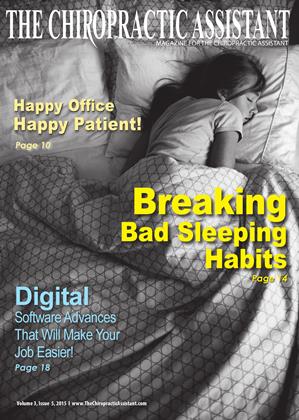Twelve Problems Great Software Can Solve
Aaron Jones
Working in a chiropractic office sometimes can feel like a revolving wheel of chaos. There is always more work to be done, new rules to comply with, and less time in the day (or so it seems). Fortunately, the tools available to chiropractors and CAs are improving every day, and the thoughtful implementation of software tools, in particular, can really minimize some of the most vexing problems facing an office.
Let's take a moment to break down 12 specific issues that you might be facing and how software can be your solution:
1. Easy Conversion from ICD-9 to ICD-10
ICD-10 is looming like a monster, waiting to devour those who are unprepared later this year. If you already have ICD-9 codes recorded in billing software, though, you may be able to easily convert those codes to their ICD-10 equivalents, or at least see a limited set of related options. In addition, software makes it easier to search for codes while you are still unfamiliar.
2. Catch Patients Before They Go Missing
Earning a new patient is a very expensive process. From marketingto consultation, and atmosphere to attitude, you invest a lot in your next generation of patients, so don't let them slip away. Software has the power to alert you to patients who are in danger of falling out of care so that you can rescue them and complete their scheduled treatment plans.
3. Fast and Easy EOB Recording
EOBs are time consuming. They can represent hours of work and toil, but what you may not know is that most payers and clearinghouses offer an electronic version of the EOB that can be read by billing software. Implementing electronic EOBs (ERA or 835 files) could save you hours every week.
4. Automatic Appointment Reminders
Reminding patients of an upcoming appointment greatly increases their compliance. E-mail and text message reminders are targeted, unobtrusive, and can be dispatched with little or no time investment on your part. In fact, some software systems allow
for e-mail and text message reminders to be sent automatically every day at no cost to the office.
5. Show Patients What They Owe
Collecting outstanding patient balances can be frustrating and confusing. Often, the patient's liability is difficult to discern, but great software can isolate and simplify that balance on a ledger or statement. Batching out statements targeted directly at those who still owe can be quick and painless.
6. Flexible and Fast Insurance Billing
Gone are the days of slow, noisy printers and complex, step-by-step claim batching. Electronic billing is easy with the right software and clearinghouse combo. With just a few clicks, an electronic batch of claims can be on its way to a one-stop shop, and responses can be obtained online within minutes or hours of submission.
7. Compact and Organized Doctor's' Notes
A DC's notes are as personal and varied as chiropractors are. Moving to electronic notes can be traumatic for some offices, but preparing a case for submission is never easier than when the notes, exams, and narrative are all complete and in one
place. Additionally, making it a habit to create electronic notes at the time of service is the key to eliminating the fee slip (or superbill) from your patient flow.
8. Detailed Stats and Reports
Getting a big picture of your office's receivables and stats can be difficult when records are kept on paper or by an off-site biller. The right software, however, can streamline your billing and patient management processes, as well as provide meaningful reports to help you track progress, manage inventory, and resubmit unpaid claims.
9. Patient Sign-In and Signature Capture
Many clinics take the time to collect a patient's signature on a sign-in sheet and to have the patient rate his or her pain at the time of the visit. Great software can do this in a much more efficient manner, saving those signatures for future recall and preparing the daily note with preloaded subjective ratings. Another advantage offered by these features is a great degree of HIPAA security.
10. Visit Counts and Payment Plans
More and more offices are integrating cash plans into their business model, and more and more insurance companies are setting visit limits for patient care. Using software to establish and track these plans puts up-to-the minute information at your fingertips. A scary administrative burden is made simple through the power of properly wielded software.
11. Pop-Up Patient Alerts and Reminders
PQRS, reexaminations, treatment plan changes, supplement recommendations, and collection reminders can create a disorganized mess of patient charts. Using software, you can create meaningful, targeted alerts for patients that prompt the proper action at the proper time. This creates efficiency, saves time, and reduces stress.
12. Worry-Free Meaningful Use of an EHR
Meaningful use can be daunting to say the least. Not every software system is created equal in this regard, but great software can make meaningful use compliance automated, and can provide you with straightforward tools for checking your progress.
Aaron Jones is the Vice President of Operations at tgi Software, developers of the 2014 certified EHR AutumnS. Living the adventure of raising two small children, he and his wife Jessica share their unquenchable curiosity and passion for excellence with their colleagues, clients, family andfriends. 800-645-4309
 View Full Issue
View Full Issue






